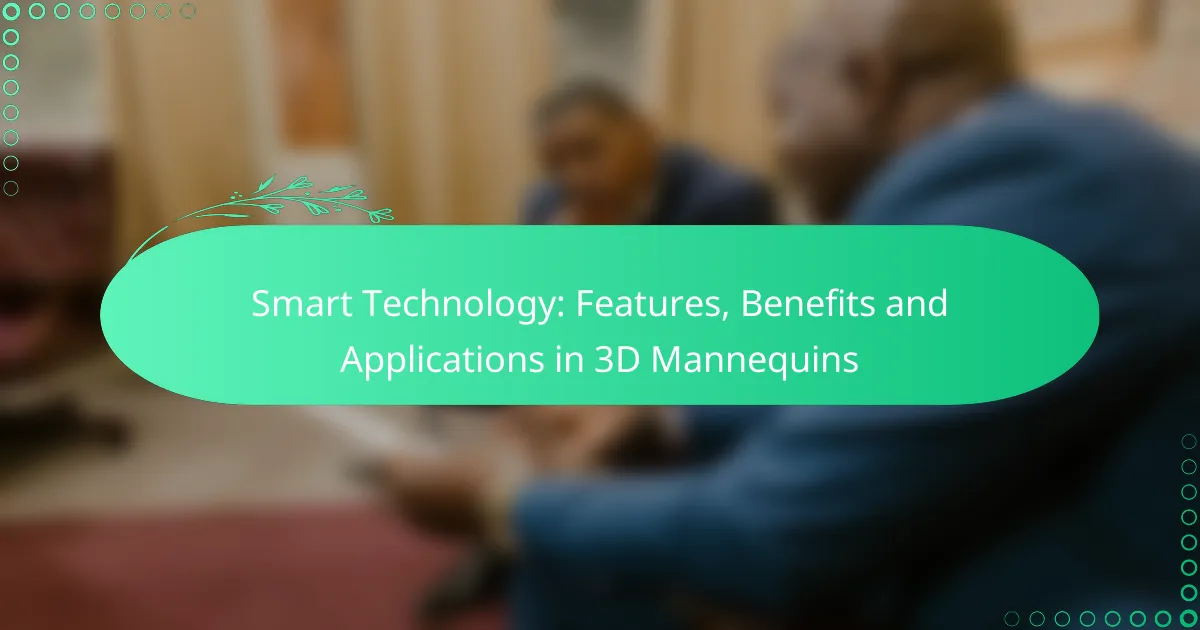Smart technology in 3D mannequins revolutionizes the retail landscape by incorporating advanced features that enhance interactivity and customization. These innovative tools not only create engaging shopping experiences but also optimize inventory management and marketing strategies, leading to increased sales and valuable consumer insights.

What are the features of smart technology in 3D mannequins?
Smart technology in 3D mannequins incorporates advanced features that enhance interactivity, data integration, and customization. These capabilities allow retailers and brands to create engaging shopping experiences while optimizing inventory management and marketing strategies.
Interactive displays
Interactive displays on 3D mannequins enable customers to engage directly with the product offerings. Touchscreens or gesture recognition systems can showcase different clothing options, sizes, or colors, allowing shoppers to visualize their choices in real-time.
These displays can also feature product information, promotional content, or even virtual fitting options, enhancing the overall shopping experience. Retailers should consider the placement and usability of these displays to maximize customer interaction.
Real-time data integration
Real-time data integration allows 3D mannequins to connect with inventory systems and customer databases. This feature enables instant updates on stock levels, sales trends, and customer preferences, facilitating informed decision-making for retailers.
By analyzing this data, businesses can adjust their marketing strategies and inventory accordingly, ensuring they meet customer demand effectively. Implementing robust data security measures is crucial to protect sensitive information during this integration process.
Augmented reality capabilities
Augmented reality (AR) capabilities in 3D mannequins enhance the shopping experience by overlaying digital information onto the physical environment. Customers can use AR applications to see how clothing would look on them without trying it on physically.
This technology can also provide styling suggestions or outfit combinations, making it easier for shoppers to visualize their purchases. Retailers should ensure that the AR experience is user-friendly and accessible across various devices.
Customizable appearances
Customizable appearances allow retailers to modify the look of 3D mannequins to reflect seasonal trends, brand identity, or specific marketing campaigns. This flexibility can include changing the mannequin’s clothing, accessories, or even facial features.
By tailoring the appearance of mannequins, brands can create a more personalized shopping experience that resonates with their target audience. It’s important to regularly update these customizations to keep the display fresh and engaging.
Remote management
Remote management capabilities enable retailers to control and update 3D mannequins from a distance. This feature allows for quick adjustments to displays, content, and settings without the need for physical presence at the location.
Using cloud-based systems, retailers can efficiently manage multiple locations and ensure consistency across their brand presentations. It is essential to have a reliable internet connection and a user-friendly interface for effective remote management.

What are the benefits of using smart technology in 3D mannequins?
Smart technology in 3D mannequins offers numerous advantages, including enhanced customer interaction, increased sales, and valuable marketing insights. By integrating advanced features, retailers can create immersive shopping experiences that drive engagement and improve overall performance.
Enhanced customer engagement
Smart 3D mannequins engage customers by providing interactive experiences that traditional displays cannot match. These mannequins can showcase products in dynamic ways, such as changing outfits or demonstrating features, which captures attention and encourages exploration.
For instance, a smart mannequin might allow customers to use touch screens to see how different clothing items look together or even simulate how they would fit. This level of interaction fosters a deeper connection between the customer and the brand.
Improved sales conversion rates
Utilizing smart technology in 3D mannequins can lead to higher sales conversion rates by making the shopping experience more appealing and informative. When customers can visualize products in a more engaging manner, they are more likely to make a purchase.
Retailers have reported increases in conversion rates by significant margins when implementing these mannequins, as they help customers make quicker and more informed decisions. This is particularly effective in fashion retail, where visual appeal is crucial.
Cost-effective marketing solutions
Smart 3D mannequins serve as cost-effective marketing tools by reducing the need for extensive advertising campaigns. They can display multiple products and promotions simultaneously, allowing retailers to maximize their marketing efforts without additional costs.
For example, a single smart mannequin can showcase seasonal collections, special offers, and even customer testimonials, all while attracting foot traffic. This versatility helps retailers optimize their marketing budgets and reach a broader audience.
Data-driven insights
One of the key benefits of smart technology in 3D mannequins is the ability to gather data on customer interactions. Retailers can track how long customers engage with the mannequins, which products attract the most attention, and even demographic information.
This data can inform inventory decisions, marketing strategies, and store layouts, ultimately leading to a more tailored shopping experience. By leveraging these insights, retailers can enhance their offerings and better meet customer needs, driving loyalty and repeat business.

How are smart 3D mannequins applied in retail environments?
Smart 3D mannequins are utilized in retail settings to enhance customer engagement and streamline the shopping experience. They provide interactive features that allow customers to visualize products in a more immersive way, ultimately driving sales and improving customer satisfaction.
Virtual fitting rooms
Virtual fitting rooms leverage smart 3D mannequins to allow customers to try on clothing digitally. Shoppers can see how garments fit and move on a virtual representation of themselves, which can reduce return rates and increase purchase confidence.
Retailers should ensure that the virtual fitting technology is user-friendly and accurately represents sizes and styles. Offering a range of sizes and styles can help cater to diverse customer preferences and body types.
Product demonstrations
Smart 3D mannequins can showcase product features through dynamic demonstrations. For example, they can display how a jacket performs in different weather conditions or how a pair of shoes adapts to various terrains.
To maximize effectiveness, retailers should focus on high-demand products and highlight unique selling points. Interactive elements, such as touchscreens, can further engage customers by allowing them to explore product details at their own pace.
Interactive advertising
Interactive advertising using smart 3D mannequins creates engaging experiences that attract customers’ attention. These mannequins can display promotional content, seasonal collections, or even social media feeds that encourage customer interaction.
Retailers should consider integrating QR codes or NFC technology to allow customers to access additional information or special offers directly through their smartphones. This approach can enhance the shopping experience and drive traffic to both physical and online stores.

What factors should businesses consider when choosing smart technology for mannequins?
Businesses should consider budget constraints, integration with existing systems, and user-friendliness when selecting smart technology for mannequins. These factors significantly influence the effectiveness and efficiency of the technology in enhancing retail experiences.
Budget constraints
Budget constraints play a critical role in the decision-making process for smart technology. Businesses need to evaluate both initial costs and ongoing expenses, such as maintenance and software updates. A well-defined budget helps in identifying options that provide the best value without compromising essential features.
When assessing costs, consider a range of prices for smart mannequins, which can vary widely based on features and capabilities. Investing in higher-quality technology may lead to better long-term returns through improved customer engagement and sales.
Integration with existing systems
Integration with existing systems is essential for seamless operation. Businesses should ensure that the smart technology can easily connect with current inventory management, point-of-sale, and customer relationship management systems. This compatibility can enhance data flow and operational efficiency.
Before making a purchase, conduct a thorough assessment of the current systems in place. Look for smart mannequins that offer APIs or built-in compatibility with popular software platforms to minimize disruption during implementation.
User-friendliness
User-friendliness is crucial for both staff and customers. Technology that is easy to operate will lead to better employee adoption and a more engaging customer experience. Look for features such as intuitive interfaces and straightforward setup processes.
Consider providing training sessions for staff to familiarize them with the new technology. Additionally, gather feedback from customers to ensure that the smart mannequins enhance their shopping experience rather than complicate it.

What are the leading brands of smart 3D mannequins?
The leading brands of smart 3D mannequins include several innovative companies that specialize in integrating technology with fashion display. These brands are recognized for their advanced features, such as interactivity and data analytics, which enhance retail experiences.
1. 3DLOOK
3DLOOK is known for its mobile body scanning technology, allowing retailers to create personalized fitting experiences. Their mannequins can capture body measurements accurately, which helps in recommending sizes and styles to customers.
Retailers using 3DLOOK can expect improved customer satisfaction and reduced return rates due to better fitting options. Their technology is particularly beneficial for online shopping platforms.
2. Naked Labs
Naked Labs offers smart 3D mannequins that provide a full-body scan in seconds. This brand focuses on health and fitness applications, allowing users to track body changes over time.
Their mannequins are equipped with a rotating platform and a 3D scanner, making it easy for users to get detailed body metrics. This can be useful for fitness centers and health-focused retailers.
3. Vue.ai
Vue.ai combines artificial intelligence with 3D mannequin technology to create virtual fitting rooms. Their mannequins can simulate how clothing fits on different body types, enhancing the online shopping experience.
Retailers using Vue.ai can leverage AI-driven insights to optimize inventory and improve customer engagement, making it a valuable tool for e-commerce businesses.
4. Zeekit
Zeekit specializes in virtual fitting solutions that allow customers to see how clothes will look on them without trying them on physically. Their technology integrates with various retailers to provide a seamless shopping experience.
This brand’s smart mannequins are particularly effective in reducing fitting room congestion, making it easier for customers to shop comfortably.
